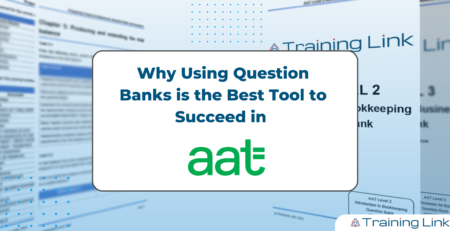Financial Accounting – Preparing Financial Statements (FAPS) Exam; What AAT Students Should Know

The AAT level 3 Financial Accounting: Preparing Financial Statements (FAPS) exam will be next in the line up financial accounting exams that students will sit.
This unit builds upon the knowledge that was learnt within the Introduction to Bookkeeping and Principles of Bookkeeping Controls units at level 2.
For the FAPS exam, you’ll have 2 hours and 30 minutes to complete 6 tasks. There are 120 marks on offer, and as usual, you’re required to achieve 70% or above, meaning you’ll need a minimum of 84 marks to achieve that all-important pass.
The FAPS exam currently sits at a UK average of 60.9%. The main difficulty that students face with this exam is the understanding of more complex accounting adjustments such as accruals and prepayments, disposals and allowance for doubtful receivables. Understanding the core fundamentals will significantly help you to be able to tackle any questions that are thrown your way.

Exam Task Breakdown
Task 1 – Task 1 is worth 28 marks and is based around non-current assets, so here you can expect questions involving a non-current asset register, depreciation (and that could be calculating it or accounting for it) and disposals of non-current assets. Make sure you’re comfortable with the postings when disposing of an asset on both a standard sale or when part exchanging.
Task 2 – is worth 14 marks and is on period-end adjustments. Here, I’d expect to see questions on accruals and prepayments, allowance for doubtful receivables and potentially a question on inventory valuation under IAS 2. For accruals and prepayments make sure you’re comfortable with the adjustments for both income and expenditure and practise questions where they refer to having an opening balance on the account relating to a prior accrual or prepayment so that you get a feel of how to do the reversal, as well as the year-end postings.
Task 3 – is worth 24 marks and is on adjustments and the trial balance. Here, I’d expect to see a question on the extended trial balance, some form of journal adjustments that need posting and possibly something where you need to reconcile transactions. This is a slightly more varied task where a strong understanding of double-entry bookkeeping will be key to achieving the required marks.
Task 4 – is also worth 24 marks and is on the financial statements for sole traders and partnerships. Here I’d expect to see a question on the Statement of Profit or Loss or Statement of Financial Position or both of them! Another common topic for this task will be the partner’s current accounts. Practice as many SPL and SOFP questions as possible and they’ll become second nature. This shouldn’t be too challenging a task if you’ve put the practice in.
Task 5 – is worth 18 marks and is on principles and interpretation of financial statements. Here, I’d expect to see questions on performance ratios and interpreting those ratios. There’s no secret trick to these, unfortunately, but as long as you’ve ingrained them into your brain by the time it gets to your exam, you’ll be absolutely fine. These are something you’ll also need to know very well for level 4 too, so getting them committed to memory early on is only a good thing.
Task 6 – is the last task and worth 12 marks so the smallest on the exam. These questions will cover incomplete records, so make sure you’re comfortable with calculating markup and margin when both the sales or cost of sales have been given. Also, familiarise yourself with how you’d calculate these as part of the cost of sales calculation to find out missing closing inventory for example. Other aspects you may see are reconstructing accounts or assessing the likelihood of figures.

AAT Examiner’s Report
The examiner’s report is available to all students and to access this you can head over to the AAT lifelong learning portal and go to the Financial Accounting: Preparing Financial Statements unit, where you can find the PDF to download.
The report shows the performance on the exam by task and gives key strengths and weaknesses for each task.
There are two points that jump out at me, firstly on task 2, “making entries in the journal to record the value of closing inventory.” One of the key parts to this, which students sometimes miss, is that closing inventory is recorded in both the Statement of Profit or Loss and the Statement of Financial Position. It is a credit entry within the Statement of Profit or Loss as a reduction to the cost of sales figure (after all, how can it be a cost of sale if you haven’t yet sold it!) and also a debit entry in the SOFP as an asset to the business.
The other point that jumped out at me was on task 3, “identifying the effects of transactions on the accounting equation”. This is an interesting one because I think being able to categorise accounts into assets and liabilities is a fundamental skill within your double-entry bookkeeping knowledge. Knowing how accounts are affected when a transaction is entered, i.e. how it moves up and down in value, will be key when correcting errors. This is another area of weakness that has been picked up in the examiner’s report.
Final Thoughts
The Financial Accounting: Preparing Financial Statements exam has one of the lowest exam results out of any AAT exam. The main point when tackling this exam will be making sure that your understanding of the more complex double-entry principles is very strong. Try your absolute best to avoid memorising where the double-entry should go because if a question is asked in a different format, you’ll then struggle to be able to answer it. If, however, you have a strong understanding of the double-entry principles, then there is no reason that you can’t go through this exam without any problems.
If you need further help please don’t hesitate to get in touch with your tutor.
Alternatively, why not try out a Live Class?
Book your slot with our expert tutors who lead exclusive weekly Live Class sessions.
Stay tuned for more updates, success stories, and insights from our community.
Together, let’s continue to strive for excellence and make a difference through hard work and dedication.










